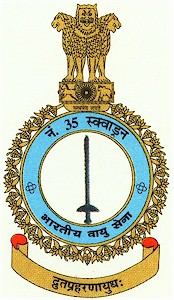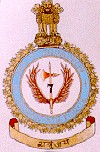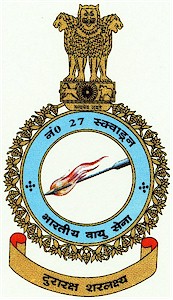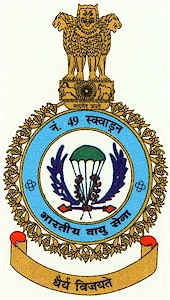
The Indian Air Force (IAF) is the air arm of the Indian Armed Forces. Its primary mission is to secure Indian airspace and to conduct aerial warfare during armed conflicts. It was officially established on 8 October 1932 as an auxiliary air force of the British Empire which honoured India's aviation service during World War II with the prefix Royal. After India gained independence from United Kingdom in 1947, the name Royal Indian Air Force was kept and served in the name of the Dominion of India. With the transition to a republic in 1950, the prefix Royal was removed.

Air Chief Marshal Pratap Chandra Lal, DFC was the Chief of Air Staff (CAS) of the Indian Air Force (IAF) during the Indo-Pakistani War of 1971. He served in the IAF from 1939 until his retirement in 1973. He was the CAS at the time of Operation Chengiz Khan, the preemptive strikes that were carried out by the Pakistan Air Force (PAF) that marked the formal initiation of hostilities of the war.

No. 35 Squadron IAF (Rapiers) was an electronic warfare and air superiority squadron of the Indian Air Force (IAF). It was based at Bakshi Ka Talab Airforce Station, No. 35 Squadron came under the Central Air Command; and along with No. 108 Squadron formed an operational wing of the IAF. As of 2017, it was equipped with MiG-21M aircraft. The squadron was number plated in 2019.

No. 7 Squadron, Indian Air Force operates as a Special Munitions Delivery and air superiority unit. Based at Gwalior AFB, No.7 Squadron forms a part of 40 Wing AF, Central Air Command.
The Eastern Air Command is one of the five operational commands of the Indian Air Force. Currently headquartered in Shillong in Meghalaya. Named No. 1 Operational Group at the time of its inception, 27 May 1958, it was based at Ranikutir in Kolkata as a part of the Govt's increasing emphasis on defence of the eastern borders. The Operational Group was upgraded as Command on 1 December 1959 with headquarters at Fort William, Kolkata and Air Vice Marshal KL Sondhi as the first AOC-in-C of the Eastern Command. After the 1962 Indo-Chinese War, The decision was made to raise a full-fledged command at Shillong. The area of responsibility of the command now covers 11 states, and is bound by the international boundaries of Nepal, Bhutan, China, Myanmar and Bangladesh incorporating 6300 km of common border. Eastern Air Command now has permanent airbases at Chabua, Guwahati, Bagdogra, Barrackpore, Hasimara, Jorhat, Kalaikunda and Tezpur with forward airbases at Agartala, Kolkata, Panagarh and Shillong. Eastern Air Command consists of Air Defence squadrons consisting of the MiG-21 and Ground attack squadrons consisting of the MiG-27. It holds the motto "Samareshu Parakramaha",
East Pakistan Air Operations covers the activity of the Pakistan Air Force (PAF) and Pakistan Army Aviation units in former East Pakistan during the Bangladesh Liberation War. The operations involved the interdiction, air defense, ground support, and logistics missions flown by the Bangladesh Air Force, Indian Air Force, and the Indian Navy Aviation wing in support of the Mukti Bahini and later Indian Army in Bengal.
The Western Air Command (WAC) is the regional command of Indian Air Force headquartered in New Delhi. It is the largest and most important Air Command of the IAF, comprising sixteen Air Force Bases (AFBs), and is responsible for aerial defence of North India.
The Central Air Command is one of the five operational commands of the Indian Air Force. It is currently headquartered in Prayagraj in Uttar Pradesh. It was formed on 19 March 1962, at Rani Kuthee, Calcutta.
Training Command is the Indian Air Force's command responsible for flying and ground training.

No. 27 Squadron IAF is a Ground-Attack and Close Air Support squadron of the Indian Air Force, operating from Gorakhpur AFS, under Central Air Command.

Air Chief Marshal Hrushikesh Moolgavkar, PVSM, MVC was a former Air officer in the Indian Air Force. He served as the 9th Chief of the Air Staff of the Indian Air Force from 1 February 1976 till 31 August 1978.
No. 106 Squadron ("Lynxes") is a squadron of the Indian Air Force. It was raised on 1 May 1957 with eight newly inducted PR.57 English Electric Canberras in the strategic photo-reconnaissance role. Initially positioned at Bareilly, later the squadron moved to Agra. When the Canberras were retired in 2007, the squadron was equipped with Hawker Siddeley HS 748 ("Avros"). The motto of the squadron is "Sarva Peshayami".

No. 43 Squadron is a unit of the Indian Air Force assigned to Eastern Air Command. The squadron participates in operations involving air, land and airdrop of troops, equipment, supplies, and support or augment special operations forces, when appropriate.

No. 48 Squadron is a unit of the Indian Air Force assigned to Maintenance Command. The Squadron participates in operations involving air, land and airdrop of troops, equipment, supplies, and support or augment special operations forces, when appropriate.

No. 49 Squadron is a unit of the Indian Air Force assigned to Eastern Air Command. The Squadron participates in operations involving air, land and airdrop of troops, equipment, supplies, and support or augment special operations forces, when appropriate.
No. 11 Squadron is a unit of the Indian Air Force assigned to South Western Air Command. The Squadron participates in operations involving air, land and airdrop of troops, equipment, supplies, and support or augment special operations forces, when appropriate.
No. 59 Squadron is located at Gauhati under Eastern Air Command. The Squadron participates in operations involving air, land and airdrop of troops, equipment, supplies, and support or augment special operations forces, when appropriate.

No. 45 Squadron Indian Air Force is a Fighter Squadron internally based at Sulur AFS, Tamil Nadu. The squadron operates the indigenous HAL Tejas fighter from 1 July 2016. The squadron was initially based at Bangalore, Karnataka and later shifted to its main base in Sulur from 1 June 2018.

No. 221 Squadron (Valiants) is an Indian Air Force fighter squadron and is equipped with Su-30MKI and based at Halwara Air Force Station.

Air Vice Marshal Harjinder Singh, PVSM, MBE was an Air Officer in the Indian Air Force. He was one of the earliest to join the newly created Indian Air Force (IAF) in 1933 in the lowest rank of 'Hawai sepoy'. In a career spanning over three decades and two wars, he rose from the lowest enlisted rank to the then second-highest rank in the Indian Air Force. Hailed as technical wizard and innovator, he is considered a legend of the IAF.












